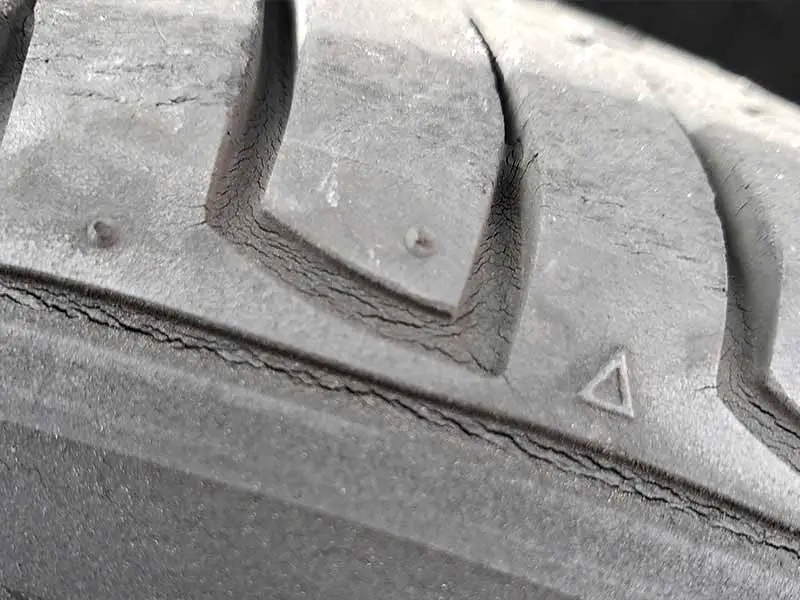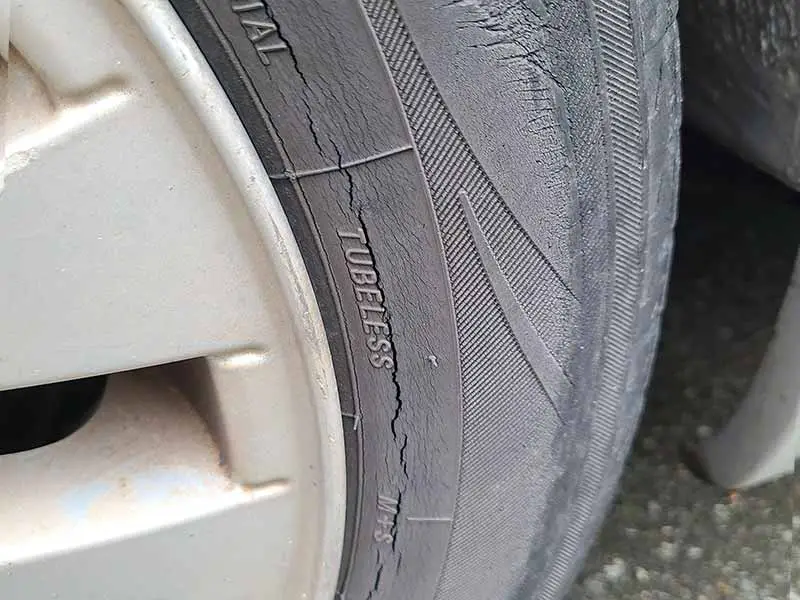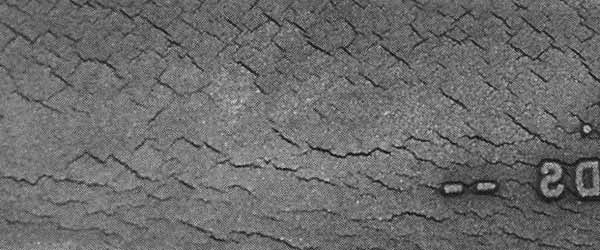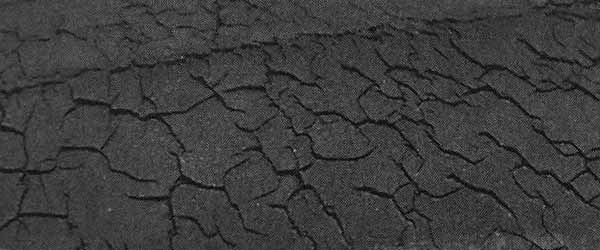Pushing the limits of how much tire life you can squeeze out can save you a lot of money, but tire dry rot can also be very dangerous if pushed too far. Minor tire dry rot doesn’t mean you should replace your tires, but you will definitely what to understand how far you can let it go.
When Is Dry Rot On Tires Dangerous?
Dry rot on tires is dangerous when it exceeds 1/16 inch (2mm) in depth. At this point, the rubber’s brittleness compromises the tire’s structural integrity. Tires with minor dry rot but sufficient tread depth can still be safely used, but should be replaced once the dry rot surpasses this threshold.
In this article, we’ll cover the important factors to know about dry rot on tires, covering crucial topics such as the safety of driving on dry rotting tires and determining the right time to replace them.
Let’s take a closer look.

When Should Dry-Rotted Tires Be Replaced?
Deciding when to replace dry-rotted tires is important for maintaining the safety and performance of your vehicle. In this section, we’ll discuss the signs of dry rot on tires, as well as factors to consider when deciding whether it’s time for a replacement.
Signs Of Dry Rot On Tires
- Cracks In The Sidewall: One of the most visible signs of dry rot is cracking in the tire’s sidewall. These cracks can range from small, hairline fractures to larger, more noticeable gaps. Keep an eye out for any cracks, as they could indicate that the rubber is becoming weak and brittle.
- Discoloration: Discoloration is another sign of dry rot. Over time, the tire’s rubber may become faded or turn a brownish color. This can indicate that the tire is losing its protective oils and is becoming more susceptible to dry rot and other types of damage.
- Deformed Or Brittle Rubber: When you run your hand over the surface of a tire with dry rot, you might notice that the rubber feels rough, brittle, or uneven. This can be a sign that the tire’s structure is compromised and that it may not perform as well as it should on the road.
Factors Affecting Tire Replacement
- Severity Of Dry Rot: The severity of the dry rot will play a big role in determining whether it’s time to replace your tires. If the cracks are small and shallow, you might still have some time before the tires become unsafe. However, if the cracks are large and deep, it’s a good idea to replace the tires as soon as possible.
- Age Of The Tire: Even if your tires don’t show obvious signs of dry rot, it’s important to consider their age. Tires generally have a lifespan of around 6-10 years, depending on factors like usage and storage conditions. If your tires are approaching this age range, it’s a good idea to have them inspected by a professional and consider replacing them, even if they look okay.
- Usage Conditions: The way you use your vehicle can also influence when you should replace your tires. If you frequently drive on rough or uneven surfaces, your tires may be more susceptible to dry rot and other types of damage. Similarly, if you live in an area with extreme temperatures or lots of sunlight, your tires may be more prone to dry rot. In these cases, it’s a good idea to be proactive and replace your tires sooner rather than later.

What Does Bad Tire Dry Rot Look Like?
Being able to recognize bad tire dry rot is essential for keeping your vehicle safe and performing well on the road. In this section, we’ll discuss the most severe signs of dry rot and how to identify when your tires are in need of immediate attention.
Identifying Severe Dry Rot
- Large Cracks Or Gaps In The Rubber: When dry rot becomes severe, you might notice large cracks or gaps in the tire’s rubber. These can appear on the sidewall or in the tread of the tire, and they indicate that the tire’s structure is significantly weakened. If you see cracks like these, it’s important to replace your tires as soon as possible to avoid the risk of a blowout or other tire failure.
- Tire Tread Separation: One of the most dangerous signs of bad tire dry rot is tread separation. This occurs when the outer layer of the tire, which includes the tread, starts to separate from the underlying layers. You might notice a bulging or wavy appearance in the tread or feel a vibration while driving. If you suspect that your tire is experiencing tread separation, it’s crucial to have it inspected and replaced immediately, as this can lead to a sudden and catastrophic tire failure.
- Bulges Or Bubbles In The Sidewall: In some cases, severe dry rot can cause bulges or bubbles to form in the tire’s sidewall. These are areas where the internal structure of the tire has been compromised, allowing air to seep between the layers of rubber. If you see bulges or bubbles on your tire, it’s a clear sign that the tire is no longer safe to drive on and should be replaced as soon as possible.
Level One Dry Rot

Level Two Dry Rot

Level Three Dry Rot

Level Four Dry Rot

Level Five Dry Rot

Can You Reverse Tire Dry Rot?
There’s no way to fix dry rot tires once it sets in. However, there are steps you can take to prevent further deterioration and extend their remaining life. In this section, we’ll discuss tire maintenance practices that can help keep sidewall cracking and dry rot at bay and the limitations of reversing dry rot.
Prevention And Maintenance
- Proper Tire Inflation: One of the best ways to prevent dry rot is to keep your tires properly inflated. Underinflated tires can cause excessive heat buildup, which can contribute to dry rot. Check your tire pressure regularly and make sure it’s within the recommended range for your vehicle. You can find this information in your owner’s manual or on a sticker inside your driver’s side door.
- Avoid UV Rays: Keeping the tire rubber out of the sun’s UV rays as much as possible is a great way to help prevent tire dry rot. Parking in shaded areas or storing tires in dark environments will go a long way toward helping to prevent developing dry rot.
- Protection From Extreme Temperatures: Extreme temperatures, both hot and cold, can accelerate the dry rot process. If possible, park your vehicle in a garage or shaded area to protect your tires from direct sunlight and temperature fluctuations. Using tire covers or shades can also help protect your tires from the elements.
Limitations Of Reversing Dry Rot
- Extent Of The Damage: If your tires already have significant dry rot, it may be too late to prevent further damage. In these cases, the safest option is to replace the tires. While proper maintenance can help slow the progression of dry rot, it’s crucial to recognize when a tire is no longer safe to use.
- Age Of The Tire: The age of your tire also plays a role in its susceptibility to dry rot. As tires get older, the rubber naturally degrades, making it more prone to dry rot. Even with proper maintenance, tires have a limited lifespan and will eventually need to be replaced.

How Long Can Tires Sit Before They Go Bad?
Tires have a limited lifespan, even when they’re not in use. In this section, we’ll explore the factors that influence how long tires can sit before they go bad and how to store tires properly to maximize their lifespan.
Factors Affecting Tire Degradation
- Age Of The Tire: Tires have a natural aging process, which can cause them to degrade over time, even if they’re not in use. Most tire manufacturers recommend replacing tires every 6-10 years, regardless of their appearance or tread depth. This is because the rubber compounds in the tire will break down over time, making them more prone to dry rot and other issues.
- Storage Conditions: The way you store your tires can greatly affect how long they can sit before going bad. Exposure to sunlight, extreme temperatures, and moisture can all contribute to the degradation of your tires. Proper storage conditions can help slow down this process and keep your tires in better shape for longer.
Proper Tire Storage
- Clean And Dry The Tires: Before storing your tires, make sure they’re clean and dry. Dirt and moisture can contribute to tire degradation, so it’s essential to remove any debris and allow the tires to dry thoroughly before putting them away.
- Keep Tires Away From Direct Sunlight: Store your tires in a cool, dark place, away from direct sunlight. Ultraviolet (UV) light can cause the rubber in your tires to break down more quickly, leading to dry rot and other issues.
- Maintain Proper Tire Pressure: Even when tires are in storage, it’s important to maintain the correct tire pressure. This helps to prevent flat spots and ensures the tire’s structure remains stable. Check the tire pressure periodically and adjust as needed.
- Elevate Tires Off The Ground: Store your tires on a rack or shelf, elevated off the ground. This helps prevent moisture and dirt from coming into contact with the tires, which can cause damage over time.
Resources
Below are some links you may find helpful when learning about tires
Final Thoughts
Dry rot can weaken your tires and make them more prone to failure, so it’s important to monitor their condition regularly and take action when necessary.
Remember the key points we discussed throughout this article:
- Dry rotted tires can be unsafe to drive on, especially if the cracking is severe or widespread.
- It’s important to replace dry-rotted tires when they show signs of significant damage or reach the end of their expected lifespan.
- Regular tire maintenance and proper storage can help prevent dry rot and extend the life of your tires.
Don’t wait for dry rot to become severe; stay proactive in monitoring your tires and consult with a tire professional if you have concerns about their condition.
Good luck and happy motoring.




